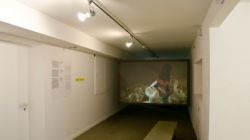
Tamar Raban / Dora
Tamar Raban
Born in Haifa, 1955
Lives and works in Haifa and Tel Aviv
In 1997, Tamar Raban created the performance Dinner Dress - Tales About Dora, which was performed several times at Miklat 209 and at Performance Art Platform in Tel Aviv, at the Israel Museum, Jerusalem, and at festivals in Vienna, Zurich, and Hamburg. The audience was invited to participate in a meal prepared by the chef Tzahi Bukshester, which took place around a round table over the course of an hour. The artist stood at the center of the table, "emerging" from it as if it were part of her dress. The source of inspiration for this dress-table and for the female figure emerging from it was the Infanta in Velבzquez's Las Meninas. At the same time, Dinner Dress was also a tribute to Judy Chicago's The Dinner Party. According to Raban, her decision to name the female figure she created "Dora" was intuitive - Dora was, for her, a generic representation of femininity.
Dora
The name given by Tamar Raban to her work acquired a life of its own, and gave rise to various cultural and personal associations. The best-known association was with Freud's famous patient Dora, one of the most prominent figures in the history of psychoanalysis. Her real name was Ida Bauer, and Freud saw her over a period of 11 weeks in 1900. He presented her case history in the article "Fragment of an Analysis of a Case of Hysteria," which was published in 1905. Freud's interpretation of Dora's case was later critiqued in feminist circles, above all due to the identification he created between femininity and hysteria.
The "second" Dora is Dorothea Kupfer (Dvora Motiuk), Tamar Raban's mother (Berlin, 1922 - Haifa, 1973). Only in retrospect did Raban realize that Dora was short for her mother's German name, which she had changed in Israel to "Dvora."